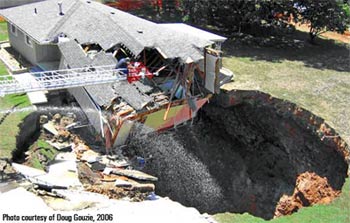What causes sinkholes? How to detect sinkholes? And how to prevent sinkholes?
Those are questions that’ve been on many minds lately, following the INCREASING numbers of giant sinkholes forming in the US and around the world.

As the name suggests, sinkholes are naturally occurring holes in the surface of the earth. Sinkholes can form gradually or – in most cases – suddenly.
They form in areas where water flowing underground has dissolved rock – typically limestone – below the surface, leading to the formation of underground voids into which the surface sediment falls. They vary in size from 1 to 600 meters.
Sinkholes are found all over the world. In the U.S., sinkholes are especially common in Texas, Alabama, Missouri, Kentucky, Tennessee, Pennsylvania, and Florida.
Look at these US sinkhole maps.
Experts say that thousands of sinkholes form in Florida each year. There’s hardly a place in Florida that’s immune to sinkholes. In addition to sitting on highly porous limestone, the state has additional factors that can lead to the formation of sinkholes, including extreme weather and aquifer pumping.
In an effort to prevent injuries, deaths, and property losses caused by sinkholes, scientists have tested various methods of detecting the underground cavities that can lead to sinkholes. These include radar, seismography, and electrical resistivity testing.
Discover some of the most impressive sinkholes around the world.
You don’t have to be a scientist to be able to recognize certain signs that a sinkhole is about to open up. A brochure issued by the Southwest Florida Water Management District lists several sinkhole warning signs, including slumping trees or fence posts; the formation of small ponds in areas where water has not collected before; wilting of small, circular areas of vegetation; and structural cracks in walls.
But despite efforts to spot sinkholes before they occur, there are still plenty of unpleasant – and occasionally tragic – surprises. There’s no accurate way of ever predicting where a sinkhole is going to occur.













what kind of a professional can verify why a sinkhole occured?
what has to be done to repair a sink hole?
[…] Signs that sinkholes may be near include slanted trees, ponds where water does not usually pool and circular patches of wilting vegetation. […]
ミルガウス (Milgauss) 三針式、日付機能無で、ケース内に収められた軟鉄製の帯磁ケースでムーヴメントを保護しており、1000ガウスの耐磁性能を備えたモデル(ミルガウスの『ミル』はフランス語で「1000」の意味)。初期型は稲妻形の秒針を備えRef.6541、Cal.1066。後に稲妻型の針は通常の直線針に変更され、1980年代末に一度生産が打ち切られたが、2008年に再び稲妻型の針を付けて復活した。
ルイヴィトン財布 激安 6帖 http://www.newkakaku.net/ldb1.htm
[…] How to detect sinkholes? […]
[…] Sinkholes are common hazards in mining regions, plaguing areas where miners have burrowed into layers of soluble minerals and accidental floods have followed. But natural sinkholes can take thousands of years to form and vary in size. They are usually the result of what are known as Karst processes, which occur when a layer of rock such as limestone underneath the ground is dissolved by acidic water. Typically rainfall seeps through the soil, absorbing carbon dioxide and reacting with decaying vegetation. As a result, the water that reaches the soluble rock is acidic. You can read more about sinhole formation here. […]
[…] already introduced in this post, sinkholes are typical phenomena in areas, such as Florida, where the ground is made of […]
[…] A sinkhole is a hole that opens up suddenly in the ground. They mostly occur because of erosion, underground water that gathers naturally or due to man-made activities. Learn more about sinkholes here. […]
[…] in Florida and worried about a sinkhole like the one in the news this weekend? – What causes sinkhole? How to detect sinkholes? How to prevent sinkholes? Sinkhole warning signs – from Strange […]